Seabirds are one of the most endangered animal groups in the world. They are already grappling with multiple problems, including climate change, by-catch in fishing gear, and being eaten by invasive species such as cats and some rodents.
But these birds, which breed on land and feed in the sea, are now facing another threat: plastic pollution. It is becoming increasingly common to find seabirds that have ingested plastic while foraging for food.
A group of seabirds called petrels are particularly at risk. They roam large areas of the ocean and cannot easily regurgitate the plastic they ingest. During the breeding season, they may also inadvertently feed their chicks this plastic.
In our latest research, we tracked the movements of more than 7,000 petrels of 77 different species. We combined this data with existing maps of marine plastic pollution to calculate an exposure risk score for each species. These scores allowed us to build a detailed picture of when and where seabirds are most at risk of encountering plastic pollution at sea.
We have found that many species spend a lot of time in areas of the ocean with high plastic concentrations. Plastic exposure risk was highest in closed seas where plastic can become trapped, such as the Mediterranean and Black Seas. These regions account for more than half of the global plastic exposure risk for petrels, potentially affecting all four studied species that feed there.
But many other petrel species are at risk of encountering plastic in remote parts of the ocean, including the Northwest and Northeast Pacific, South Atlantic and Southwest Indian Oceans. This is mainly due to large systems of circulating ocean currents, called mid-ocean gyres, which carry plastic debris thousands of miles from their source, such as the Great Pacific Garbage Patch.
In fact, a quarter of the petrels’ plastic exposure risk occurred on the high seas. These areas are not under the jurisdiction of any country, so international efforts are needed to reduce the threat of plastic pollution to seabirds and other marine wildlife.
Vulnerable birds
The risk of plastic exposure varied by species and whether it was breeding or non-breeding season. Notably, there were also differences in plastic exposure risk between populations of the same species.
Some already threatened species scored high, including the critically endangered Balearic shearwater, which breeds in the Mediterranean. Newells’ shearwater, endemic to Hawaii, was also at high risk of plastic exposure.
Another vulnerable species, the spectacled petrel, also scored high for plastic exposure risk. This species breeds exclusively on an uninhabited volcanic island in the South Atlantic Ocean called Inaccessible Island.
Even species at low risk of exposure, such as the northern fulmar and snow petrel, have eaten plastic in the past. This demonstrates that ocean plastic pollution is a problem for seabirds around the world, even outside high-exposure areas.

Arnau Soler/Shutterstock
Plastic pollution is a problem
Seabirds often swallow plastic by mistake, mistaking it for their food. They also ingest plastic that has already been eaten by their prey.
This can lead to injury, poisoning from toxic chemicals that leak from the plastic, and starvation as the plastic fills the stomach. Research in 2014 found that more than 60% of fleshy-footed shearwater juveniles exceed international targets for plastic ingestion by seabirds. It’s concerning that 16 percent of newbies failed these goals after just one feed.
Over time, plastic debris also breaks down into tiny fragments called microplastics. Research has found that exposure to microplastics can cause inflammation in the digestive system of birds, a phenomenon called plasticosis.
We haven’t focused on the impact of plastic exposure on the petrel species studied, but many of these species are already threatened with extinction. Exposure to plastic can further reduce these birds’ resilience to the other threats they face.

Andrew Balcombe/Shutterstock
Beyond national borders
Our study marks the first time that tracking data for so many species has been combined with existing knowledge about ocean plastic pollution. This represents a big step forward in our understanding of the threat plastic pollution poses to the natural world.
A significant portion of plastic pollution accumulates on the high seas, far beyond the waters of the country where a seabird breeds. Our findings highlight the need for international cooperation to address marine plastic pollution, both directly from boats and from plastic litter on land.
Research suggests that 22% of ocean waste is likely to come from marine sources. Good waste management is therefore essential to prevent plastic waste from reaching the ocean. A key part of this will be improving compliance with the existing ban (adopted in 1973) on the disposal of any form of plastic from ships.
Seabird protection requires more than local solutions. We need regional and global treaties that address plastic pollution both in national waters and on the high seas. Only by implementing large-scale solutions can we safeguard the animals that inhabit our oceans.
#Plastic #pollution #threatens #birds #high #seas #research
Image Source : theconversation.com

